
In this section, you will:
Halley’s Comet ([link]) orbits the sun about once every 75 years. Its path can be considered to be a very elongated ellipse. Other comets follow similar paths in space. These orbital paths can be studied using systems of equations. These systems, however, are different from the ones we considered in the previous section because the equations are not linear.

In this section, we will consider the intersection of a parabola and a line, a circle and a line, and a circle and an ellipse. The methods for solving systems of nonlinear equations are similar to those for linear equations.
A system of nonlinear equations is a system of two or more equations in two or more variables containing at least one equation that is not linear. Recall that a linear equation can take the form
Any equation that cannot be written in this form in nonlinear. The substitution method we used for linear systems is the same method we will use for nonlinear systems. We solve one equation for one variable and then substitute the result into the second equation to solve for another variable, and so on. There is, however, a variation in the possible outcomes.
There are three possible types of solutions for a system of nonlinear equations involving a parabola and a line.
[link] illustrates possible solution sets for a system of equations involving a parabola and a line.
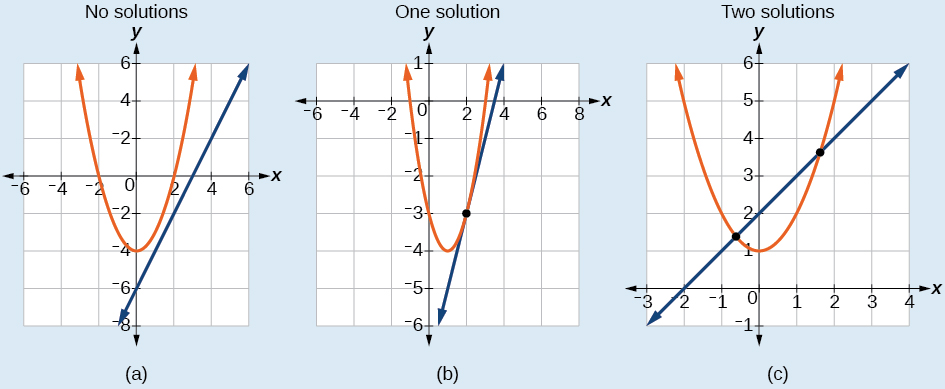
Given a system of equations containing a line and a parabola, find the solution.
Solve the system of equations.
Solve the first equation for
and then substitute the resulting expression into the second equation.
Expand the equation and set it equal to zero.
Solving for
gives
and
Next, substitute each value for
into the first equation to solve for
Always substitute the value into the linear equation to check for extraneous solutions.
The solutions are
and
which can be verified by substituting these
values into both of the original equations. See [link].
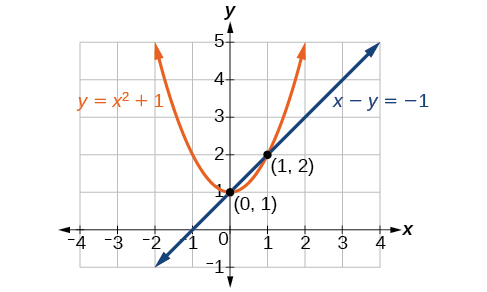
**Could we have substituted values for
into the second equation to solve for
in [link]?**
Yes, but because
</math>is squared in the second equation this could give us extraneous solutions for
</math></em>
For
This gives us the same value as in the solution.
For
*Notice that
is an extraneous solution.*
Solve the given system of equations by substitution.
and
Just as with a parabola and a line, there are three possible outcomes when solving a system of equations representing a circle and a line.
[link] illustrates possible solution sets for a system of equations involving a circle and a line.
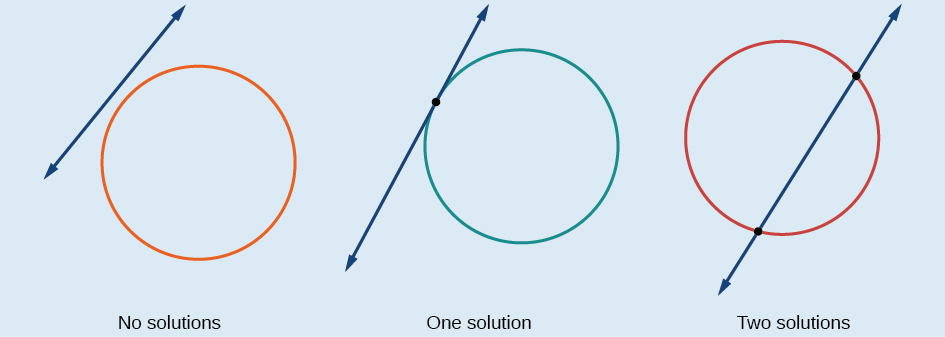
Given a system of equations containing a line and a circle, find the solution.
Find the intersection of the given circle and the given line by substitution.
One of the equations has already been solved for
We will substitute
into the equation for the circle.
Now, we factor and solve for
Substitute the two x-values into the original linear equation to solve for
The line intersects the circle at
and
which can be verified by substituting these
values into both of the original equations. See [link].
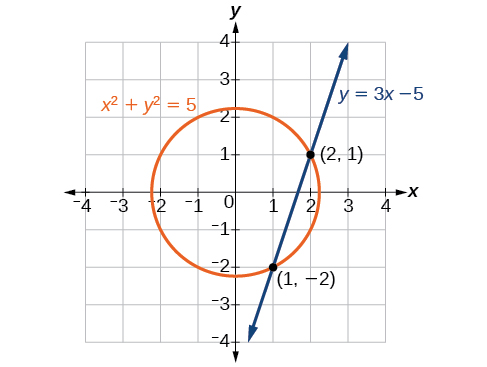
Solve the system of nonlinear equations.
We have seen that substitution is often the preferred method when a system of equations includes a linear equation and a nonlinear equation. However, when both equations in the system have like variables of the second degree, solving them using elimination by addition is often easier than substitution. Generally, elimination is a far simpler method when the system involves only two equations in two variables (a two-by-two system), rather than a three-by-three system, as there are fewer steps. As an example, we will investigate the possible types of solutions when solving a system of equations representing a circle and an ellipse.
[link] illustrates possible solution sets for a system of equations involving a circle and an ellipse.

Solve the system of nonlinear equations.
Let’s begin by multiplying equation (1) by
and adding it to equation (2).
After we add the two equations together, we solve for
Substitute
into one of the equations and solve for
There are four solutions:
See [link].
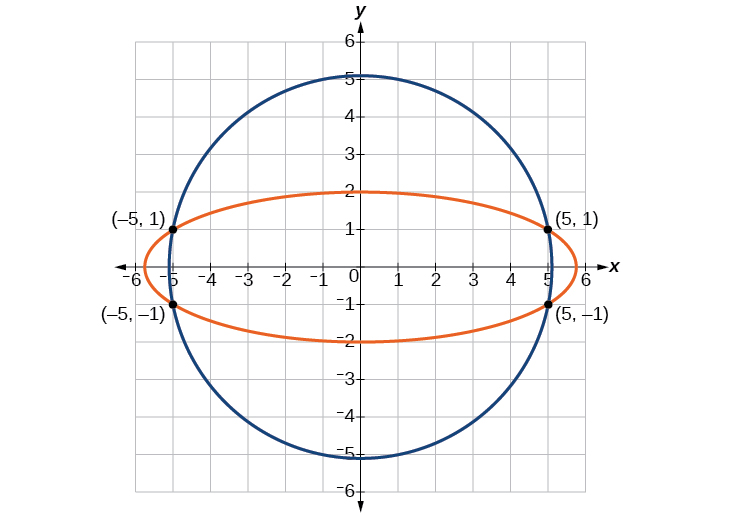
Find the solution set for the given system of nonlinear equations.
All of the equations in the systems that we have encountered so far have involved equalities, but we may also encounter systems that involve inequalities. We have already learned to graph linear inequalities by graphing the corresponding equation, and then shading the region represented by the inequality symbol. Now, we will follow similar steps to graph a nonlinear inequality so that we can learn to solve systems of nonlinear inequalities. A nonlinear inequality is an inequality containing a nonlinear expression. Graphing a nonlinear inequality is much like graphing a linear inequality.
Recall that when the inequality is greater than,
or less than,
the graph is drawn with a dashed line. When the inequality is greater than or equal to,
or less than or equal to,
the graph is drawn with a solid line. The graphs will create regions in the plane, and we will test each region for a solution. If one point in the region works, the whole region works. That is the region we shade. See [link].
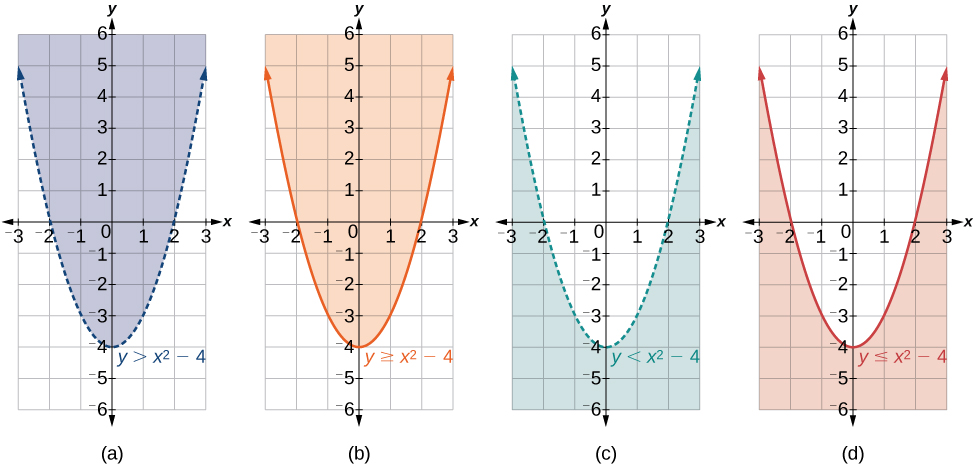
Given an inequality bounded by a parabola, sketch a graph.
or
), the parabola is graphed as a solid line.
Graph the inequality
First, graph the corresponding equation
Since
has a greater than symbol, we draw the graph with a dashed line. Then we choose points to test both inside and outside the parabola. Let’s test the points* * *
and
One point is clearly inside the parabola and the other point is clearly outside.
The graph is shown in [link]. We can see that the solution set consists of all points inside the parabola, but not on the graph itself.
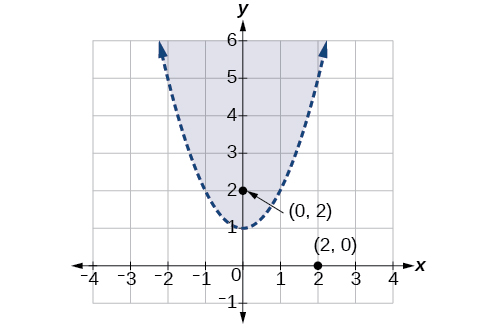
Now that we have learned to graph nonlinear inequalities, we can learn how to graph systems of nonlinear inequalities. A system of nonlinear inequalities is a system of two or more inequalities in two or more variables containing at least one inequality that is not linear. Graphing a system of nonlinear inequalities is similar to graphing a system of linear inequalities. The difference is that our graph may result in more shaded regions that represent a solution than we find in a system of linear inequalities. The solution to a nonlinear system of inequalities is the region of the graph where the shaded regions of the graph of each inequality overlap, or where the regions intersect, called the feasible region.
Given a system of nonlinear inequalities, sketch a graph.
Graph the given system of inequalities.
These two equations are clearly parabolas. We can find the points of intersection by the elimination process: Add both equations and the variable
will be eliminated. Then we solve for
Substitute the x-values into one of the equations and solve for
The two points of intersection are
and
Notice that the equations can be rewritten as follows.
Graph each inequality. See [link]. The feasible region is the region between the two equations bounded by
on the top and
on the bottom.
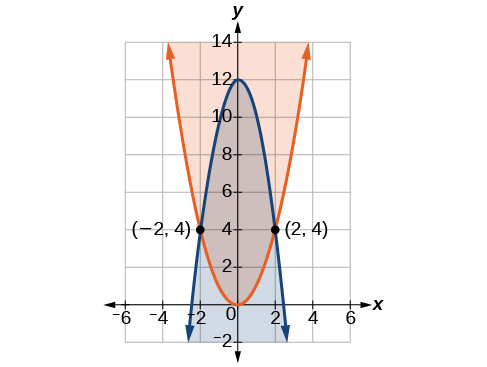
Graph the given system of inequalities.* * *
Shade the area bounded by the two curves, above the quadratic and below the line.
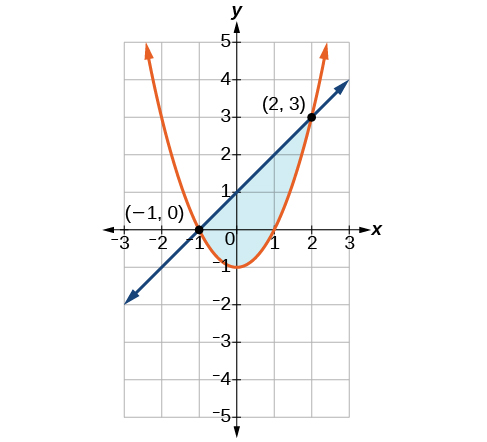
Access these online resources for additional instruction and practice with nonlinear equations.
(1) no solution, the circle and the ellipse do not intersect; (2) one solution, the circle and the ellipse are tangent to each other; (3) two solutions, the circle and the ellipse intersect in two points; (4) three solutions, the circle and ellipse intersect in three places; (5) four solutions, the circle and the ellipse intersect in four points. See [link].
Explain whether a system of two nonlinear equations can have exactly two solutions. What about exactly three? If not, explain why not. If so, give an example of such a system, in graph form, and explain why your choice gives two or three answers.
A nonlinear system could be representative of two circles that overlap and intersect in two locations, hence two solutions. A nonlinear system could be representative of a parabola and a circle, where the vertex of the parabola meets the circle and the branches also intersect the circle, hence three solutions.
When graphing an inequality, explain why we only need to test one point to determine whether an entire region is the solution?
When you graph a system of inequalities, will there always be a feasible region? If so, explain why. If not, give an example of a graph of inequalities that does not have a feasible region. Why does it not have a feasible region?
No. There does not need to be a feasible region. Consider a system that is bounded by two parallel lines. One inequality represents the region above the upper line; the other represents the region below the lower line. In this case, no points in the plane are located in both regions; hence there is no feasible region.
If you graph a revenue and cost function, explain how to determine in what regions there is profit.
If you perform your break-even analysis and there is more than one solution, explain how you would determine which x-values are profit and which are not.
Choose any number between each solution and plug into
and
If
then there is profit.
For the following exercises, solve the system of nonlinear equations using substitution.
For the following exercises, solve the system of nonlinear equations using elimination.
For the following exercises, use any method to solve the system of nonlinear equations.
For the following exercises, use any method to solve the nonlinear system.
No Solutions Exist
No Solutions Exist
For the following exercises, graph the inequality.
For the following exercises, graph the system of inequalities. Label all points of intersection.
For the following exercises, graph the inequality.
For the following exercises, find the solutions to the nonlinear equations with two variables.
No Solution Exists
For the following exercises, solve the system of inequalities. Use a calculator to graph the system to confirm the answer.
and
For the following exercises, construct a system of nonlinear equations to describe the given behavior, then solve for the requested solutions.
Two numbers add up to 300. One number is twice the square of the other number. What are the numbers?
12, 288
The squares of two numbers add to 360. The second number is half the value of the first number squared. What are the numbers?
A laptop company has discovered their cost and revenue functions for each day:
and
If they want to make a profit, what is the range of laptops per day that they should produce? Round to the nearest number which would generate profit.
2–20 computers
A cell phone company has the following cost and revenue functions:
and
What is the range of cell phones they should produce each day so there is profit? Round to the nearest number that generates profit.

You can also download for free at http://cnx.org/contents/13ac107a-f15f-49d2-97e8-60ab2e3b519c@11.1
Attribution: